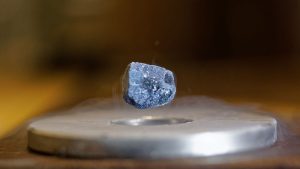
A South Korean research team has announced that they have developed a room-temperature superconducting compound that, if proven to be a viable source of the long-sought after material, could revolutionize electrical equipment across numerous scientific, medical, transportation and power generation fields.
The material, called “LK-99” by the research team, is a compound that uses lead (Pb) and copper (Cu) atoms arranged in a specific manner that produces its superconducting qualities. Superconductors are materials that, unlike ordinary materials, offer little to no resistance to an electric current that is applied to it.
This is a quality that is sought after in numerous applications where increased electrical efficiency could improve the equipment being used, such as eliminating line loss in electrical power lines, a problem that limits how far electricity can be practically transferred from its generating plant, as well as reducing the size of the transmission lines themselves.
Power generation itself can be made more efficient through the use of superconductors in electrical generators; more efficient—and possibly more compact—scientific equipment, ranging from life-saving magnetic resonance imaging (MRI) machines to clean-burning nuclear fusion reactors would also be revolutionized. Additionally, superconductive materials produce a strong magnetic field, a property that could be used to build high-efficiency maglev trains.
LK-99’s superconductivity appears to hinge on a change in its molecular structure when it is fabricated: the poly-crystalline structure of the material undergoes a minute reduction in volume during the fabrication process—just by 0.5 percent—when the Pb ions in the structure are replaced by Cu ions; the resulting stresses exerted by the shrinkage “creates superconducting quantum wells (SQWs)” within the material’s structure.
The result is that LK-99 remains superconductive up to 127°C (260°F) while at ambient atmospheric pressure, an important quality if it is to be used in electrical equipment that either runs hot or is used in a hot environment, although the efficiencies gained by using superconductive material in electrical equipment would serve to reduce the device’s heat output to begin with.
LK-99 also exhibited what is called the Meissner effect, enabling it to levitate when placed in a magnetic field. Although the demonstration of this effect was incomplete, with the sample only partially levitating, the research team said that this was due to impurities present in the sample; future samples are expected to perform better than the initial products.
“The LK-99 has many possibilities for various applications such as magnet, motor, cable, levitation train, power cable, qubit for a quantum computer, THz antennas, etc.” the study paper states. “We believe that our new development will be a brand-new historical event that opens a new era for humankind”
Subscribers, to watch the subscriber version of the video, first log in then click on Dreamland Subscriber-Only Video Podcast link.
So very intriguing. Yesterday I read another article that also deals with electricity. ‘Electrified Cement’ Could Turn The Foundations of Buildings Into Giant Batteries. The thought that crossed my mind is, WHAT IF THE ANCIENTS USED A SIMILAR METHOD AND APPLIED IT TO THE ANCIENT STRUCTURES LIKE THE GREAT PYRAMID OF GIZA? A concrete mix? Would it have created a channel from one pyramid structure to the next as another way of communication????? Just thinking out-loud here. Nikola Tesla, wish we could talk with you now.
https://www.msn.com/en-us/news/technology/electrified-cement-could-turn-the-foundations-of-buildings-into-giant-batteries/ar-AA1eFBIH?ocid=msedgdhp&pc=U531&cvid=404104a0fa164d349b087693cb03c230&ei=6
UPDATE: There’s good news and bad news regarding this story…
The good news is that LK-99 is relatively easy to produce–something that would be key in scaling production to industrial levels.
This ease of production also means that other laboratories can reproduce the material in short order, of which leads to the bad news: other labs report that LK-99 isn’t actually a superconductor, but gives the appearance of one by mimicking superconductive properties that appear as an ordinary material transitions into superconductivity as it’s cooled.
Although LK-99 doesn’t appear to be panning out as a proper superconductor, I’d imagine it’s low electrical resistance and magnetic properties might make it a useful material in practical applications anyhow. In the meantime, it’s back to the drawing board…
https://en.wikipedia.org/wiki/LK-99